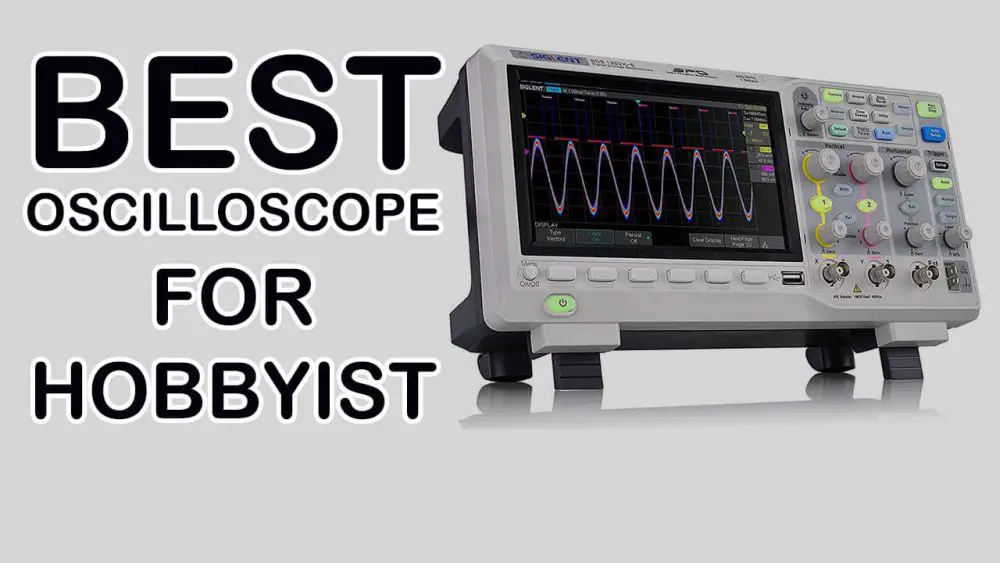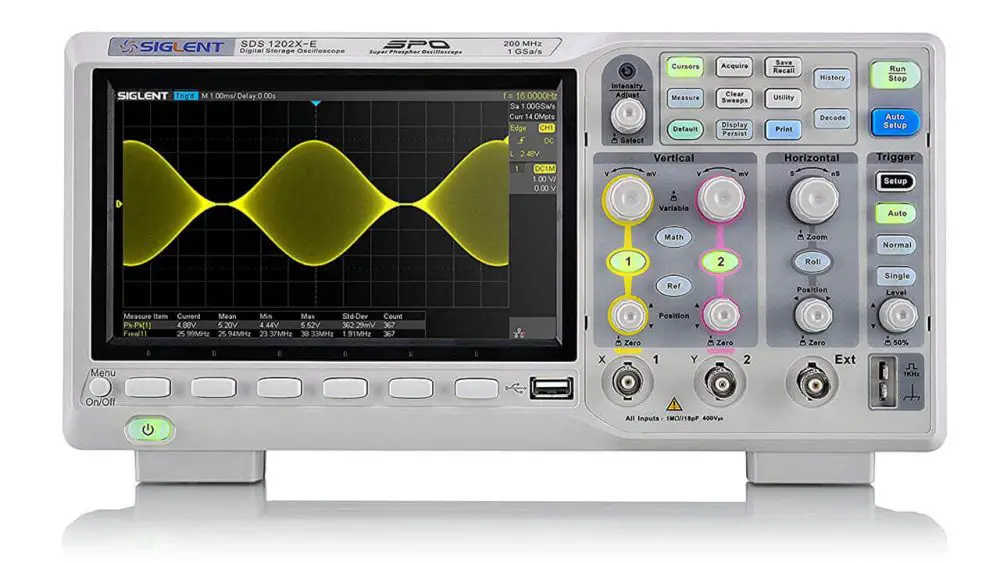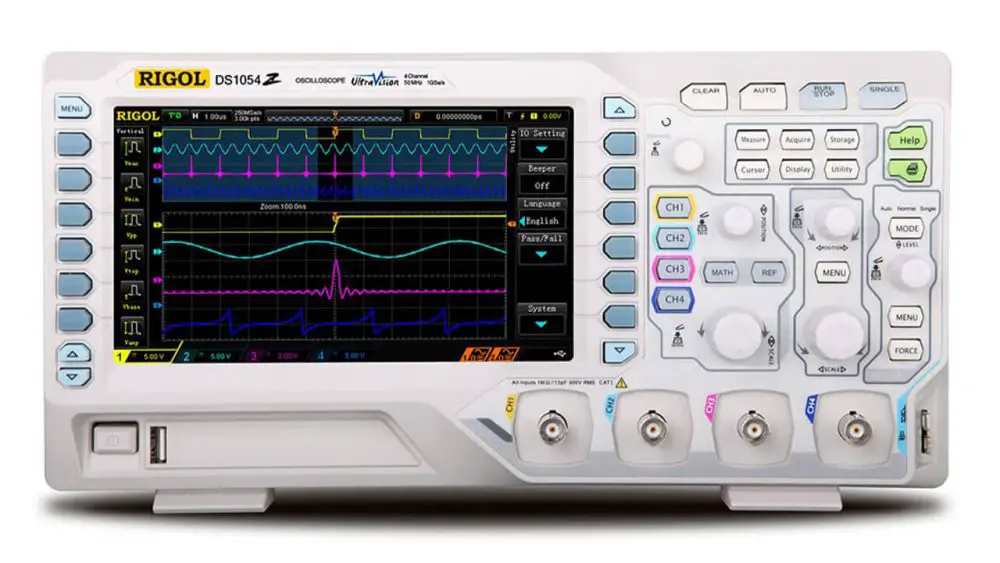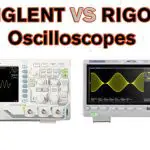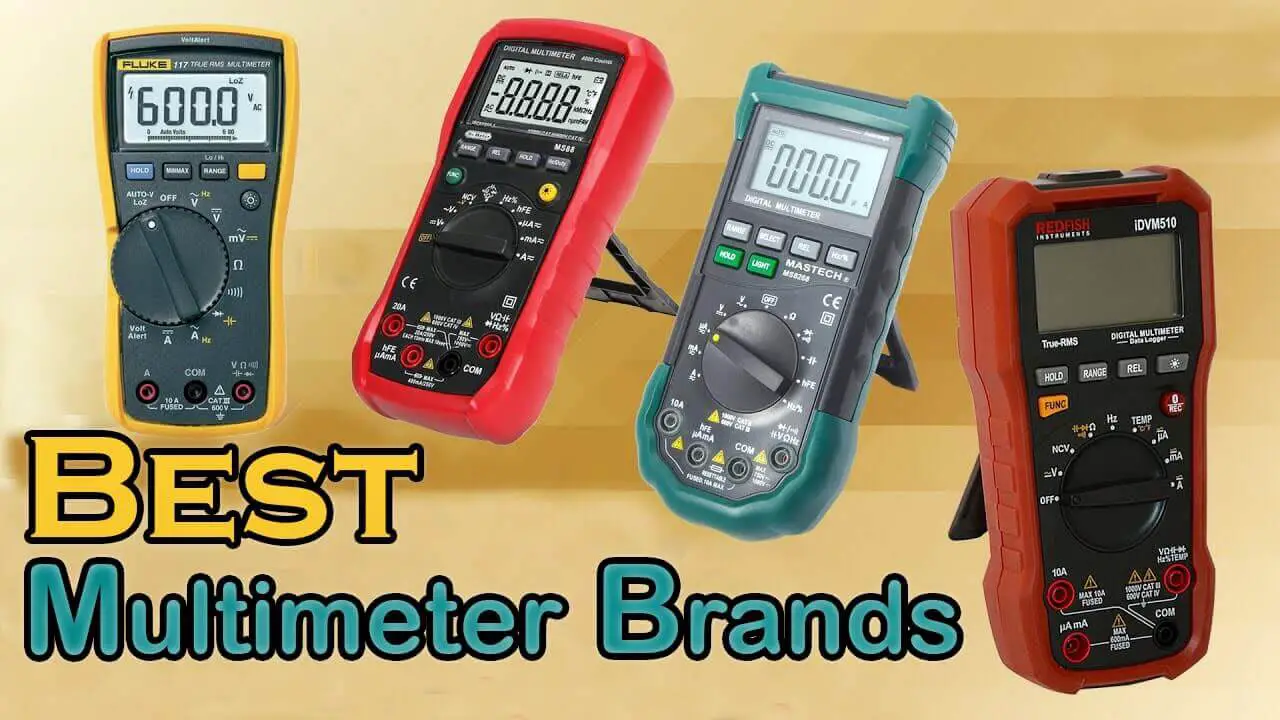BEST OSCILLOSCOPE FOR HOBBYIST
When dealing with an electronic circuit, An oscilloscope is a device that displays signal waveforms as they flow through circuits. also, a versatile instrument that can be used for a variety of functions, including electrical system troubleshooting and analysis It come in several forms and sizes, so selecting the perfect one for your purposes is critical. We’ll show you how to choose the best oscilloscope for your requirements in this article. Whether you’re a newbie or an electronics hobbyist.
At a glance:
9.7
- BANDWIDTH: 100 MHz
- A real-time sampling rate of 1 GSa/s
- A waveform memory of 14 MPts
- Its USB and LAN ports make it simple to connect to your computer or network
- This oscilloscope supports Wi-Fi, but only via USB
9.5
- BANDWIDTH: 200 MHz
- A real-time sampling rate of 1 GSa/s
- Its USB and LAN ports make it simple to connect to your computer or network
- A waveform memory of 14 MPts
- It features an incredible noise level of 1mV/div
9.0
- Analog channel bandwidths of 100 MHz, 70 MHz, and 50 MHz.
- A real-time sampling rate of 1 GSa/s.
- A waveform memory of 24 Mpts.
- This device contains four analog channels and 16 digital channels
What Is An Oscilloscope?
An oscilloscope is a graphical tool that can be used to observe the behaviour of processes in electronic circuits. The electrical signal s time parameters and amplitude can be recorded and measured, which is fed into the oscilloscope. The oscilloscope can be used to visualize and investigate the behaviour of electronic circuits.
When you are building circuits, it is often important to be able to measure voltage. However, when you are working with more complex circuits, an oscilloscope can be more effective. A multimeter can be a useful tool when measuring voltages in simple circuits, but it is less effective when you need to measure voltage in more complex circuits.
How do you choose the best oscilloscope for your requirements?
There are several characteristics and requirements to consider when selecting an oscilloscope. The price, size, features, and compatibility are all important factors to consider. It is essential to select the oscilloscope that best suits your requirements while remaining within your budget. The following is a list of some of the most important specifications to look for when purchasing an oscilloscope.
5 factors you must consider while choosing an oscilloscope:
- Bandwidth
- Sample rate
- Number of channels
- Memory depth
- Price
Bandwidth:
The bandwidth of an oscilloscope is the range of frequencies that it can accurately measure. The Hertz frequency rating of the scope determines this range. An entry-level scope often has a MegaHertz bandwidth rating, which indicates it can measure frequencies up to 10 million times per second. Higher-end scopes feature gigaHERtz and teraHERtz ratings, allowing them to measure frequencies up to 100 billion and 1 trillion times per second, respectively.
Sample rate:
The sampling rate of an oscilloscope determines its capacity to capture a waveform with high resolution. The higher the sample rate, the greater the resolution of the waveform.
Higher resolutions provide a more precise representation of fast-moving data, facilitating
interpretation and analysis. When determining the sample rate of an oscilloscope,
several aspects must be considered: the type of application being used, the type of signal being captured, and the resources available.
The number of channels:
An oscilloscope is a tool for viewing and analyzing waveforms, which can be electrical or mechanical. The number of oscilloscope channels or inputs is essential because it defines how many signals you can monitor and analyze at the same time. Entry-level oscilloscopes typically have two or four channels. More channels allow you to view more signals at the same time, which is useful for troubleshooting a complex problem.
Memory depth:
The memory depth of an oscilloscope relates to how many samples or data points it can store. The greater the depth of memory, the longer we can show or analyze a signal. This is especially handy when searching for specific data points or events over a longer period.
Price:
When purchasing an oscilloscope, one of the first things to consider is your budget. This can be a challenging selection due to the high cost of oscilloscopes. However, we must consider our overall financial situation before making this purchase. We must consider the price, bandwidth, sample rate, and other factors of the oscilloscope. Oscilloscopes come in a variety of shapes and sizes, with many brands to choose from.
3 Best Oscilloscopes for Hobbyists and Professionals
1. Siglent Technologies SDS1104X-E
Our top pick for the best oscilloscope on the market is the Siglent SDS1104X. This oscilloscope has four channels, which is significantly more than almost all other oscilloscopes. One of the main reasons we chose this model was its great quality. This oscilloscope can record signals at speeds of up to 100 million samples per second, making it perfect for examining very high-frequency signals.
The Siglent SDS1104X-E digital oscilloscope is an excellent tool for those that need to analyze and decode information recorded on buses. The bus decoding function displays the information in a tabular format, which makes it easy to understand. Additionally, the interval setting makes it simple to compare different signals.
The Siglent SDS1104X-E oscilloscope has four channels, search and navigation, an on-screen Bode plot, 16 digital channels (optional), and an external USB-powered 25-MHz AWG module (option). This powerful tool is excellent for circuit analysis and signal processing.
Key Features:
- BANDWIDTH: 100 MHz
- REAL-TIME SAMPLING RATE: A real-time sampling rate of 1 GSa/s
- WAVEFORM MEMORY: A waveform memory of 14 MPts.
- MAXIMUM WAVEFORM CAPTURE RATE: A waveform capture rate of 100,000 frames per second in standard mode and 400,000 frames per second in sequence mode.
- Control Interface: The advanced web-based remote control interface enables users to connect to and control the device from any computer or mobile device that has a web browser.
- Bode Plot function: The Bode Plot function makes it easy to visualize frequency response data.
- Ports: Its USB and LAN ports make it simple to connect to your computer or network.
- MSO: It also has MSO functionality, which enables you to view waveforms and data from multiple channels at the same time.
- Display mode: With the Intensity-Graded display mode and Color-Temperature display mode, you can get a more realistic view of what’s going on in your circuit even in low-light conditions.
- History function: This allows you to recall and compare previous waveforms displayed on the screen. This can be extremely beneficial for debugging and troubleshooting.
Pros:
An oscilloscope with a large 7-inch diagonal display.
The large colour display offers accurate recording, and the zoom feature ensures that even the smallest details are recorded.
Its 14 million point accuracy makes it an excellent choice for high-precision measurements.
It has extremely fast refresh rates, allowing it to record high-speed transient signals and display an accurate waveform.
It has a history feature that allows you to recall the most recently triggered events. Trigger events are saved in several buffers so that they can be accessed fast and simply.
Cons:
It has a wide range of functions that may be confusing to new users, but with a little practice, it may be a wonderful asset.
This oscilloscope supports Wi-Fi, but only via USB.
2. Siglent Technologies SDS1202X-E
The Siglent SDS1202X-E is a 2-channel oscilloscope with a low price-to-performance ratio. This oscilloscope offers higher bandwidth, faster processing speed, and higher FFT resolution than comparable scopes in its class. The purpose of Siglent was to design an oscilloscope that can meet the needs of researchers and engineers while remaining affordable.
The Siglent SDS1202X-E is the new generation of SPO technology, with improved signal quality and performance. The noise level of the system is also lower than that of comparable market products.
This oscilloscope offers a 200 MHz bandwidth, a maximum capture rate of 100,000 in Normal mode or 400,000 in Sequence mode, and a real-time sampling rate of 1 GSa/s. This makes it ideal for beginners, hobbyists, and professionals that require a multifunctional oscilloscope.
Key Features:
- BANDWIDTH: 200 MHz
- REAL-TIME SAMPLING RATE: A real-time sampling rate of 1 GSa/s
- WAVEFORM MEMORY: A waveform memory of 14 MPts.
- MAXIMUM WAVEFORM CAPTURE RATE: A waveform capture rate of 100,000 frames per second in standard mode and 400,000 frames per second in sequence mode.
- DISPLAY LCD: A large 7-inch (diagonal) display with 800×480 resolution, making it easier to see waveforms and data.
- SECURE ERASE FUNCTION: The function of secure erasure will completely erase all data from the oscilloscope’s internal memory, making any previous readings or configurations unrecoverable. This security feature should be on any device that saves sensitive data.
- Ports: Its USB and LAN ports make it simple to connect to your computer or network.
- VERTICAL INPUT RANGE: This powerful scope has a minimum vertical input range of 500 UV Div, making it perfect for any lab or testing environment.
- Display mode: The Intensity-Graded display mode produces a clear, concise, and easy-to-read display. The Color-Temperature display mode allows the user to change the colour of the display to make it easier to see in different lighting conditions.
- History function: This enables you to look back in time and analyze previous signals. You can also compare current signals to previous ones to observe how they’ve changed. A history function is an excellent tool for debugging circuits and troubleshooting problems.
Pros:
- It features an incredible noise level of 1mV/div, ensuring that you can acquire accurate reading without interference from background noise.
- The most remarkable is the secure erase function, which permanently erases all data from the oscilloscope’s internal memory. This ensures that your data is always secure, even if the oscilloscope is lost or stolen.
- The 7-inch (18-cm) screen is large enough to see all of the details in your waveforms.
Cons:
- The device has no Wi-Fi.
- It doesn’t have an HDMI port to connect a larger screen.
3. Rigol DS1054Z Digital Oscilloscopes
The Rigol DS1054Z Digital Oscilloscope is not your typical tool. It has a variety of features and characteristics that set it apart from its competitors. Rigol oscilloscopes are well-known for their high quality and distinctive design, making them popular among engineers and scientists.
The Rigol DS1054Z oscilloscope is an excellent instrument for measuring. It contains four channels and a bandwidth of 50MHz, allowing you to easily see the frequency range it measures in the display. The large 7inch monitor makes it simple to see what you’re looking at, and the 800 x 480 resolution enables you to view small details. This oscilloscope is an excellent choice for anyone seeking a high-quality instrument at a reasonable price.
The Rigol DS1054Z oscilloscope has a larger memory depth of approximately 12Mpts. This is upgradeable to 24Mpts, making it suitable for a wide range of applications. The Rigol DS1054Z is capable of handling a variety of signals, including digital, analog, and mixed signals. It has several features that make it an excellent choice for use in testing and monitoring devices.
The Rigol DS10 is a complex formula system that helps in the effective and fast solution of complex signal calculations. As a result, you won’t have to struggle or waste time trying to solve problems. This device is ideal for anyone who needs to do their task fast and efficiently. This device will make your life easier with its simple User experience.
Key Features:
- BANDWIDTH: Analog channel bandwidths of 100 MHz, 70 MHz, and 50 MHz.
- REAL-TIME SAMPLING RATE: A real-time sampling rate of 1 GSa/s.
- CHANNELS: This device contains four analog channels and 16 digital channels for measuring and analyzing a variety of signals.
- WAVEFORM MEMORY DEPTH: A waveform memory of 24 Mpts.
- MAXIMUM WAVEFORM CAPTURE RATE: A waveform capture rate of up to 30,000 waveforms per second.
- DISPLAY LCD: It has a 7-inch WVGA (800×480) TFT LCD with an intensity graded colour for a clear and colourful display.
- Ports: USB Host and Device, LAN (LXI), and AUX are among the interfaces available. This makes it simple to connect to a computer or other data-transfer device.
- Display mode: The Intensity-Graded display mode produces a clear, concise, and easy-to-read display. The Color-Temperature display mode allows the user to change the colour of the display to make it easier to see in different lighting conditions.
Pros:
- It doesn’t take up much space on your workbench.
- It’s simple to use, so you can focus on getting your work done rather than learning how to use it.
Cons:
- All channels are served by a single encoder block.
- This device does not have any external synchronization input.
Frequently Asked Questions:
An oscilloscope is a device that can electrically convert the invisible world into a visible and understandable visual display. It can help in the detection of electrical faults, the measurement of voltage and frequency, and the testing of electronic components. With its ability to graphically display how signals change over time, an oscilloscope can be a useful tool for understanding the inner workings of electrical circuits.
The two types of oscilloscopes are analog and digital. Analog oscilloscopes use a beam of electrons to display waveforms, while digital oscilloscopes use sampling and a memory to store waveforms. Analog oscilloscopes are typically less expensive, but they are limited in the number of waveforms they can store. Digital oscilloscopes can store an unlimited number of waveforms and provide more accurate measurements than analog oscilloscopes.
Do you need an oscilloscope but don’t want to spend the money? Or maybe you only need it occasionally and don’t want to haul around a bulky piece of equipment. Now there’s a solution – with a USB digital storage oscilloscope, you can turn your laptop into an oscilloscope! This handy device plugs into your computer’s USB port and records waveforms for later analysis. It’s easy to use and makes it possible to capture signals from anywhere.
CONCLUSION:
An oscilloscope is a powerful tool that can be used to observe and analyze electronic waveforms. Oscilloscopes have a much wider bandwidth than multimeters, which makes them ideal for analyzing complex waveforms. The most important thing is always the bandwidth – make sure you get one with a wide enough range to cover the signals you’ll be working with. Price comes later.
According to our research, the Siglent SDS1104X-E is the best option we can recommend. It has superior features and performance compared to its competitor, the Rigol DS1054Z, in terms of features and performance.
